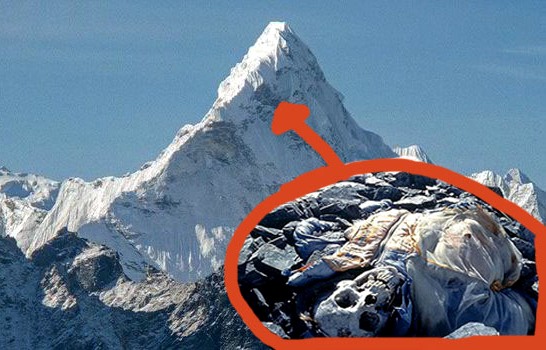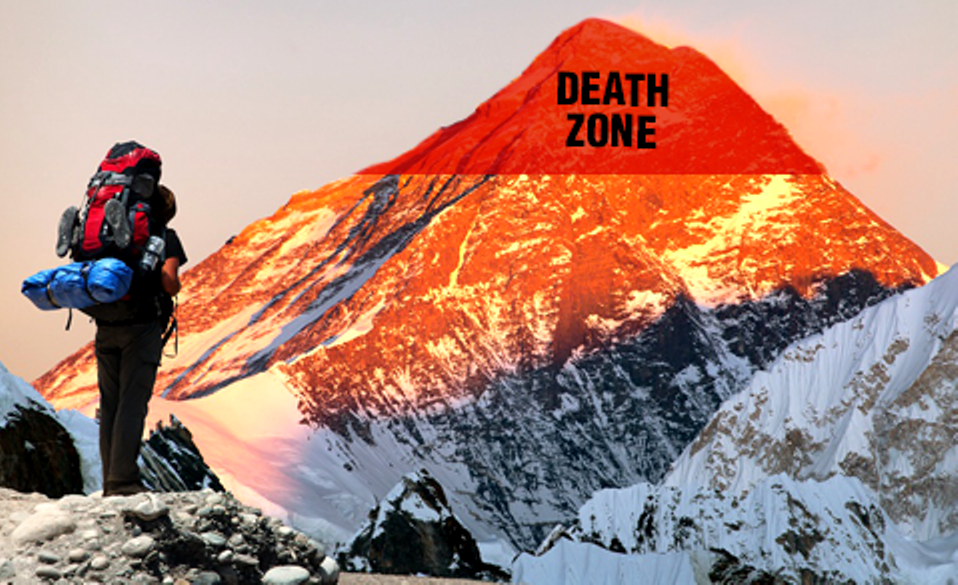

On this month's Morbidly Fascinating Page:
The dead bodies left behind on Mount Everest over the past century
In the Morbidly Fascinating Archives
Was Fox Mulder Right?
Strange Tombstones from Over the World
The Haunted Lemp Mansion
Radium Poisoning in the 1920s
The Suicide Forest
Warning: graphic photos underneath this article


Mount Everest serves not only as a testament to the majesty of nature's beauty, but as an alluring siren song calling to the heart of every adventurer. Despite the risks, thousands swarm to Nepal every year in an effort to conquer the tallest point on Earth. Many of them never leave.
Over 300 bodies remain on Everest (from recent days to almost 100 years ago), giving it claim to the title of the world's largest open-air graveyard. While most Mount Everest deaths occur due to avalanches, falls, and exposure to the harsh climate, the area known as the “Death Zone” holds a terribly high body count and comes with its own unique set of problems.
The Death Zone is commonly known as the area above 26,000 feet. When the human body enters this altitude, it slowly starts to die. Then it becomes a race against the clock for climbers to make it from this mark to the peak and back again before their body fails them. Since oxygen at this level is only a third of what it is at sea level, climbers may find themselves sluggish, disoriented, and fatigued. The pressure makes weight feel ten times heavier and causes extreme distress on organs. Because of these severe effects, climbers usually only have a window of 48 hours inside the Death Zone and are strongly urged to use supplemental oxygen at all times.
If someone dies on Everest, it's almost impossible to retrieve their body, especially in the Death Zone. Due to unbearable weather conditions, severe lack of oxygen, pressure on dead weight, and the fact that many bodies on Mount Everest are completely frozen onto the mountain face, most corpses are left exactly as they fall. Attempts are sometimes made to retrieve the body of a loved one, but those expeditions can cost upward of $25,000 and are extremely dangerous for the retrieval team.
Overall, standard protocol is to simply let these figures, frozen in the final moments of death, become a permanent addition to the rocky terrain. It would make sense that the mountain's nickname is EVER REST.
When spring rolls around, the snow on Everest melts, exposing bodies buried under the ice for years. As more bodies appear, the Expedition Operators Association of Nepal is concerned about how to retrieve them. Recovering remains from higher altitudes can cost up to $80,000. In the meantime, some climbers have begun referring to the deceased as landmarks.
Read more HERE
Photos of dead bodies currently on Mount Everest (from various years over the past century)









Dead bodies litter Mount Everest because it's so dangerous and expensive to get them down
When people die on Everest, it can be difficult to remove their bodies. Final repatriation costs tens of thousands of dollars (in some cases, around $70,000) and can also come at a fatal price itself: two Nepalese climbers died trying to recover a body from Everest in 1984. Instead, bodies are often left lying on the mountain.
Why are climbers dying?
It’s been a particularly deadly year on Mount Everest, with 11 people dying while attempting the climb since the start of the climbing season.
Climbing Mt. Everest, which stretches to over 29,000 feet, is dangerous under the best of conditions and preparation. But overcrowding at the top of the mountain and more inexperienced climbers made things particularly dangerous this year—and exacerbated the factors that can lead to fatalities.
Most of the deaths are likely from severe altitude sickness, Jeffrey Gertsch, an associate clinical professor of neuroscience at the University of California San Diego who’s studied extreme altitude, told The Daily Beast. “If not directly, then indirectly,” he said.
As people climb higher, and the air thins further, severe illnesses set in. High altitudes and low oxygen make the membranes around the brain and around the lungs leaky, allowing fluids to get into where they’re not supposed to go, Gertsch said. “All these places in your body are made up of compartments. They’re not supposed to leak,” he said. Fluid entering the lungs is called a high-altitude pulmonary edema (HAPE), and makes it harder to get oxygen in an already oxygen-low environment. “It makes everything worse,” he said.
Fluid leaking into the brain—called a high-altitude cerebral edema (HACE)—is even more dangerous, Gertsch said. People with HACE usually start to become confused, and have poor balance and coordination. “Most people can’t even walk in a straight line,” he said.
See more HERE
Why are too many people climbing the mountain?
Nepal, one of the world’s poorest countries, relies on the climbing industry to bring in $300 million each year. It doesn’t cap the number of permits it issues or control the pace or timing of the expeditions, leaving that to tour operators and guides who take advantage of brief clear weather conditions whenever they come, leading to pileups near the peak.
Climbers are often crammed crampon-to-crampon along a sharp-edged ridge above South Col, with a 7,000-foot (2,000-meter) drop on either side, all clipped onto a single line of rope, trudging toward the top of the world and risking death as each minute ticks by.
“There are more people on Everest than there should be,” said Kul Bahadur Gurung, general secretary of the Nepal Mountaineering Association, an umbrella group of all expedition operators in Nepal. “We lack the rules and regulations that say how many people can actually go up and when.”
See more HERE
What about all the trash left on Mount Everest?



The Nepalese government has removed just over 24,000 pounds of trash from Mount Everest, according to The Associated Press. During their cleanup of the world's highest mountain, cleaners also uncovered four dead bodies.
Among the 11 tons of recovered trash from the 45-day project are food wrappers, cans, bottles and empty oxygen cylinders, Tourism Department official Danduraj Ghimire said. Cleaning up the mountain has been extremely difficult due to unpredictable weather conditions, inaccessibility of certain areas and the inherent dangers involved.
Ghimire said the four dead bodies were found by the cleaners in melting snow and were taken to base camp before being flown to a hospital in the capital for identification, AP reports. None of the bodies have been identified and it is not known when they died.
See more HERE